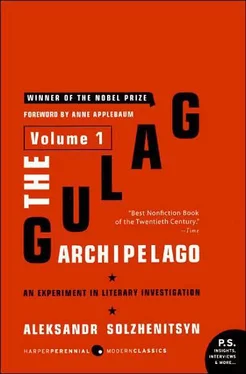Objects and actions change their aspect quite decisively depending on the position of the observer. In this chapter we have been describing the prison stand of the socialists from their point of view. And, as you see, it is illuminated by a pure and tragic light. But those KR’s whom the politicals treated so contemptuously on Solovki, those KR’s recall the politicals in their own way! “The politicals? What a nasty crowd they were: they looked down their noses at everyone else; they stuck to their own group; they demanded their own special rations all the time and their own special privileges. And they kept quarreling among themselves incessantly.” And how can one but feel that there is truth here too? All those fruitless and endless arguments which by now are merely comical. And those demands for additional rations for themselves in comparison with the masses of the hungry and impoverished? In the Soviet period, the honorable appellation of politicals turned out to be a poisoned gift. And then another reproach followed immediately: Why was it that the socialists, who used to escape so easily under the Tsar, had become so soft in Soviet prisons? Where are their escapes? In general there were quite a few escapes, but who can remember any socialists among them?
And, in turn, those prisoners “to the left” of the socialists—the Trotskyites and the Communists—shunned the socialists, considering them exactly the same kind of KR’s as the rest, and they closed the moat of isolation around them with an encircling ring.
The Trotskyites and the Communists, each considering their own direction more pure and lofty than all the rest, despised and even hated the socialists (and each other) who were imprisoned behind the bars of the same buildings and went outdoors to walk in the same prison courtyards. Yekaterina Olitskaya recalls that in 1937, at the transit prison on Vanino Bay, when the socialists called to each other across the fence between the men’s and women’s compounds, looking for fellow socialists and reporting news, the Communists Liza Kotik and Mariya Krutikova were indignant because they might bring down punishment on them all by such irresponsible behavior. They said: “All our misfortunes are due to those socialist rats! [A profound explanation, and so dialectical too!] They should be choked!” And those two girls in the Lubyanka in 1925, whom I have already mentioned, sang about spring and lilacs only because one of them was an SR and the second a member of the Communist opposition, and they had no political song in common, and in fact the Com-munist-deviationist girl shouldn’t really have joined the SR girl in her protest at all.
And if in a Tsarist prison the different parties often joined forces in a common struggle (let us recall in this connection the escape from the Sevastopol Central Prison), in Soviet prisons each political group tried to ensure its own purity by steering clear of the others. The Trotskyites struggled on their own, apart from the socialists and Communists; the Communists didn’t struggle at all, for how could one allow oneself to struggle against one’s own government and one’s own prison?
It turned out in consequence that the Communists in isolators and in prisons for long-termers were restricted earlier and more cruelly than others. In 1928, in the Yaroslavl Central Prison, the Communist Nadezhda Surovtseva went outdoors for fresh air in a single-file column that was forbidden to engage in conversation, while the socialists were still chattering in their own groups. She was not permitted to tend the flowers in the courtyard—because they had been left by previous prisoners who had struggled for their rights. And they deprived her of newspapers too. (However, the Secret Political Department of the GPU permitted her to have complete sets of Marx and Engels, Lenin and Hegel in her cell.) Her mother’s visit to her took place virtually in the dark, and her downcast mother died soon afterward. (What must she have thought of her daughter’s circumstances in prison?)
The difference between the treatment of socialist prisoners and that of the Communists persisted many years, went far beyond this, and extended to a difference in rewards: in 1937-1938 the socialists were imprisoned like the rest and they all got their tenners too. But, as a rule, they were not forced to denounce themselves: they had, after all, never hidden their own, special, individual views—which were quite enough to get them sentenced. But a Communist had no special, individual views, so what, then, was he to be sentenced for if a self-denunciation wasn’t forced out of him?
Even though the enormous Archipelago was already spreading across the land, the prisons for long-termers didn’t fall into decay. The old jail tradition was being zealously carried on. Everything new and invaluable which the Archipelago had contributed to the indoctrination of the masses was still not enough in itself.
The deficiency was provided for by the complementary existence of the TON’s—the Special Purpose Prisons—and prisons for long-termers in general.
Not everyone swallowed up by the Great Machine was allowed to mingle with the natives of the Archipelago. Well-known foreigners, individuals who were too famous or who were being held secretly, purged gaybisty, could not by any means be seen openly in camps; their hauling a barrow did not compensate for the disclosure and the consequent moral-political [280]damage. In the same way, the socialists, who were engaged in a continuous struggle for their prison rights, could not conceivably be permitted to mingle with the masses but had to be kept separately and, in fact, suffocated separately—in view of their special privileges and rights. Much later on, in the fifties, as we shall learn later in this work, the Special Purpose Prisons were also needed to isolate camp rebels. And in the last years of his life, disappointed in the possibilities of “reforming” thieves, Stalin gave orders that various ringleaders of the thieves should also get tyurzak rather than camp. And then, to be sure, it was necessary for the state to support free of charge in prison those prisoners who because of their feebleness would have immediately died off in camp and would thus have shirked their duty to serve out their terms. And others who couldn’t possibly be used in camp work—like the blind Kopeikin, a man of seventy who used to sit all day long in the market in Yuryevets on the Volga. His songs and facetious comments won him ten years for KRD—Counter-Revolutionary Activity—but in his case they had to substitute prison for camp.
The inventory of old jails, inherited from the Romanov dynasty, was, of necessity, looked after, remodeled, strengthened, and perfected. Certain central prisons, like the one in Yaroslavl, were so well and suitably appointed (doors plated with iron; table, stool, and cot permanently anchored in each cell) that the only thing required to bring them up to date was the installation of “muzzles” on the windows and the fencing in of the courtyards where the prisoners walked in order to reduce them to the size of a cell (by 1937 all the trees on prison grounds had been cut down, all vegetable gardens plowed under, and all grassy areas paved with asphalt). Others, like the one in Suzdal, required new equipment, and the monastery arrangement had to be remodeled, but, after all, self-incarceration of a body in a monastery and its incarceration in a prison by the state serve physically similar purposes, and therefore the buildings were always easy to adapt. One of the buildings of the Sukhanovka Monastery was adapted for use as a prison for long-termers. Of course, it was also necessary to make up for losses from the Tsarist inventory: the conversion of the Peter and Paul Fortress in Leningrad and of Schliisselburg near Leningrad into museums for tourists. The Vladimir Central Prison was expanded and added to—with a big new building constructed under Yezhov. It was heavily used and garnered many prisoners over those decades. We have already mentioned how the Tobolsk Central Prison was inaugurated, and that Verkhne-Uralsk was opened in 1925 for continuous and abundant use. (To our misfortune, all these isolators are still in use and are in operation at the moment these lines are being written.) From Tvardovsky’s poem “Distance Beyond Distance” one can draw the conclusion that the Aleksandrovsk Central Prison wasn’t empty in Stalin’s time either. We have less information about the one in Orel: it is feared that it suffered serious damage during World War II. But not far from it was the well-equipped prison for long-termers in Dmitrovsk-Or-lovsky.
Читать дальше












